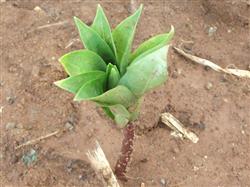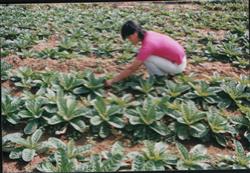How to cultivate Rehmannia glutinosa?

How to cultivate rehmannia? Is there a technical introduction to rehmannia cultivation? Dihuang cultivation can be carried out by referring to the following methods: 1. Land selection and preparation. It is advisable to select sandy loam soil with deep, fertile and good drainage. In the winter or early spring of the first year, soil is deeply plowed more than 25 cm, and 2000-3000 kg of decomposed compost and 25 kg of calcium superphosphate are applied to each mu at the same time. Then, the leveling rake fine ridge, generally ridge width of 1.3 meters. Special attention should be paid to the fact that rehmannia should not be cropped continuously, which is also a key measure to be paid attention to in land selection. 2. Selection and planting. Generally cultivated rehmannia root as a reproductive material, production said 'seed'. The 'seed' of rehmannia root is generally selected from the 'seed' cultivated in July and August of the previous year, because when the 'seed' is planted, the yield of rehmannia root is high, the quality is good, and the variety can be prevented from degeneration. Before planting, cut off the head and tail of the 'seed' and take the middle section. Then cut into 3-6 cm long sections, each section should leave two to three bud eyes, cut with plant ash, slightly dry after planting, general planting density row spacing 30-40 cm, plant spacing 25-30 cm, dig 3-5 cm deep small holes on the whole ridge surface, each hole horizontally put 'seed'1-2 sections, cover with dung water ash 1, and then cover with fine soil and ridge Qi. 40-60 kg of seeds per mu. Note that when selecting seeds, try to use 'reverse planting',' seeds', avoid using small commodities, and remove 'old mothers',' seeds'. That is, early planting seeds. 3. Field management. (1) Thinning and replenishing seedlings in time. When the seedling height is 10-12 cm, thin seedlings are started, and one strong seedling is left in each hole. In case of lack of plants, timely replanting should be carried out on cloudy days, and seedlings should be taken with soil when replanting, so that the survival rate is higher;(2) intertillage weeding. Rhizomes of rehmannia root are shallow in soil, and cultivation should be shallow to avoid damaging roots. Weeds around seedlings should be pulled out by hand. After plants are sealed, cultivation should be stopped;(3) topdressing. Dihuang likes fertilizer. Besides applying enough base fertilizer, 100kg calcium superphosphate and 30kg decomposed cake fertilizer are applied per mu after thinning to promote the development and expansion of rhizomes. When sealing rows, ashes are scattered once between rows to promote healthy growth of plants;(4) Irrigation. Dihuang needs a lot of water in the early stage, so it should be watered frequently. In the late stage, it is the period of underground rhizome expansion, so water should be saved. In rainy season, attention should be paid to timely drainage to prevent the occurrence of root rot;(5) in addition to cross-skinned roots. Dihuang in addition to the taproot, but also along the surface long slender underground stem, called string skin root, these string skin root loss of more nutrition, should be eliminated in time. IV. Pay attention to the prevention of pests and diseases. Dihuang diseases mainly include spot blight, ring disease and blight, which generally occur in early May and occur seriously from June to July, so attention should be paid to timely control; pests include red spider, cutworm, white grubs, etc., which should be eliminated by conventional methods. Attention should be paid to avoiding the use of highly toxic pesticides when selecting pesticides. 5. Harvest and processing. Spring planting rehmannia in November of the same year around the ground when the stem leaves withered should be timely mining. When digging, a deep groove of 35 cm should be opened at one end of the ridge, and the rhizomes should be carefully picked in turn; the rehmannia root is processed into rehmannia root by using a special oven, that is, it becomes a commodity. Click for more rehmannia cultivation technology Click for more herbal cultivation technology
- Prev

How to control diseases and insect pests of Yunnan Zhonglou seedlings?
How to control diseases and insect pests of Yunnan Zhonglou seedlings? Please give the introduction method Yunnan Zhonglou seedling pest control can refer to the following methods: 1, pest control. The main pests in seedling stage are ground tiger, grub and so on. Ground tigers and grubs are poisoned with 90% crystal trichlorfon (180 / mu, 200g / mu) and fried rice bran (8Mui / 10 / mu).
- Next

How to grow Rehmannia glutinosa?
How to grow Rehmannia glutinosa? Please give a detailed introduction to the planting method of Rehmannia glutinosa, also known as Rehmannia glutinosa, raw and cooked land, which belongs to the genus of Scrophulariaceae. It has the effect of nourishing yin and clearing heat, stopping bleeding and tonifying blood. It mainly treats Yin deficiency, blood deficiency, tinnitus, waist and knee pain and so on. Now its pollution-free cultivation techniques are introduced.
Related
- Fuxing push coffee new agricultural production and marketing class: lack of small-scale processing plants
- Jujube rice field leisure farm deep ploughing Yilan for five years to create a space for organic food and play
- Nongyu Farm-A trial of organic papaya for brave women with advanced technology
- Four points for attention in the prevention and control of diseases and insect pests of edible fungi
- How to add nutrient solution to Edible Fungi
- Is there any good way to control edible fungus mites?
- Open Inoculation Technology of Edible Fungi
- Is there any clever way to use fertilizer for edible fungus in winter?
- What agents are used to kill the pathogens of edible fungi in the mushroom shed?
- Rapid drying of Edible Fungi

